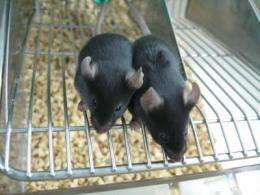From embryonic stem cells, a sperm replacement and easier path to genetic modification

Researchers reporting in the April 27 issue of the journal Cell have devised a new and improved method for producing genetically modified animals for use in scientific research. The method relies on haploid embryonic stem cells (haESCs) instead of sperm to artificially fertilize immature egg cells. Such stem cells are similar to sperm in that they carry only genetic material from a mouse "dad."
Not only will the advance make it easier to produce genetically modified mice, but it may also enable genetic modification of animals that can't be modified by today's means. The technique might ultimately be used in assisted human reproduction for those affected by genetic disease, the researchers suggest.
"The current procedure to generate genetically modified animals is tedious and very inefficient," said Jinsong Li of the Shanghai Institute for Biological Sciences. "We thought if we can generate haploid embryonic stem cells and produce semicloned animals by simply injecting those cells into oocytes, we would be certain to get a transmission into offspring with limited breeding as half of the progeny will inherit the genetic modification."
Currently, genetically modified mice are made from embryonic stem cells carrying two copies of every gene, one from mom and one from dad. These diploid embryonic cells are injected into blastocysts early in development to produce chimeras, animals whose tissues are made up of cells with one of two genomic identities. As the modified genome is randomly incorporated into the cells that will give rise to eggs and sperm, genetic modifications have the possibility to be passed on to future generations. But it's a slow and uncertain process.
Now, Jinsong Li, Guo-Liang Xu and their colleagues have found a way to generate haploid embryonic stem cells (haESCs) that can be used in place of sperm. They produce these specialized cells by first removing the nucleus from immature eggs (oocytes) and then injecting them withsperm. This procedure produces haESCs that partially retain chemical modifications characteristic of the paternal line – enough that they can be successfully used in place of sperm.
The researchers successfully produce live mice bearing haESC-carried genetic traits. These animals, which they call "semicloned mice", grew into fertile adults.
"By being amenable to gene manipulations and supporting transmission of genetic information to offspring, these haploid cells open new avenues for the generation of genetically modified animals," the researchers write. The next challenge is to improve the sperm-like features of the haESCs by optimizing their makeup without otherwise compromising them.
The new method might also lead to genetic modification of animals, such as monkeys, that have been off limits because they don't support the production of chimeras, Li says.
As for human reproduction, right now the haESCs are clearly not as good as sperm for the purposes of IVF, but they could someday have advantages. "A similar technique might be one day used to correct genetic disease in germ cells in humans to have a healthy baby for parents," Li said.
More information: Yang et al.: "Mouse Androgenetic Haploid Embryonic Stem Cells Support Targeted Gene Transmission to Progeny." DOI:10.1016/j.cell.2012.04.002
Provided by Cell Press















